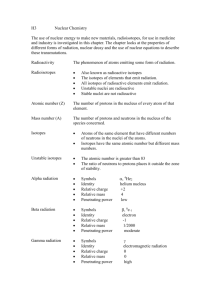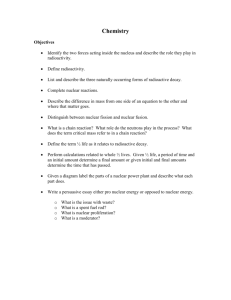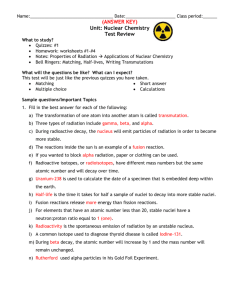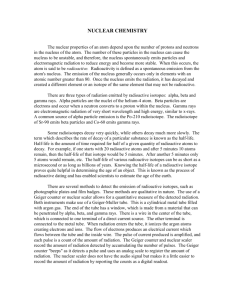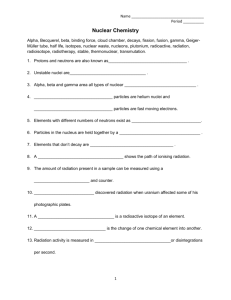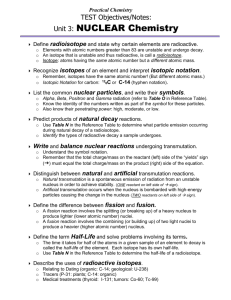Nuclear Chemistry - Duplin County Schools
advertisement
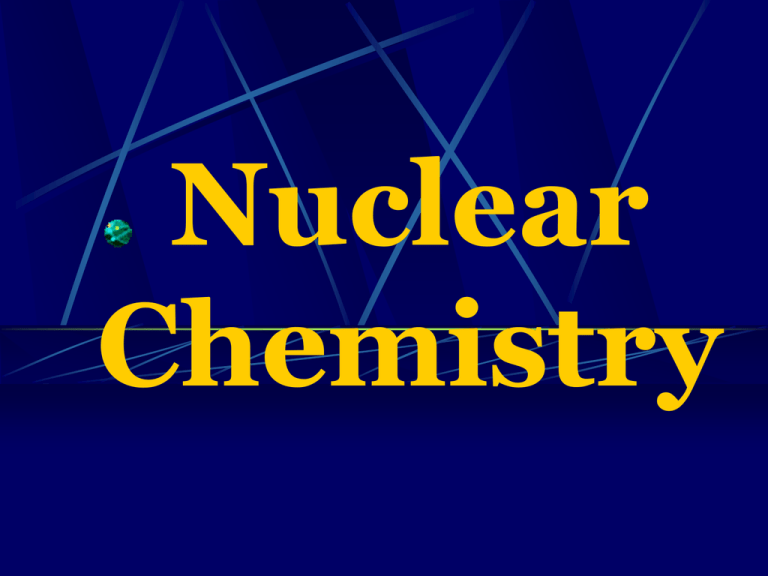
Nuclear Chemistry • Nuclear chemistry is the study of the structure of atomic nuclei and the changes they undergo. • Isotopes of atoms with unstable nuclei are called radioisotopes. • Unstable nuclei emit radiation to attain more stable atomic configurations in a process called radioactive decay. • During radioactive decay, unstable atoms lose energy by emitting one of several types of radiation. • Elements with atomic # higher than 83 are all radioactive. Types of Radiation 1. Alpha particles • Given off when a nucleus releases 2 protons and 2 neutrons • Same as a helium nucleus • Largest and slowest form of radiation • Least penetrating • Can be stopped by a sheet of paper Alpha Decay Beta particles 2. • Neutron decays into a proton and electron • Electron (beta particle) is emitted at very high speed • Proton stays in nucleus • Increases the atomic number by one – new element is formed • Does not affect the mass number • Much faster than alpha particles • Can be stopped by a thin metal foil or wood Beta decay 3. Gamma rays • Most penetrating and potentially dangerous • Highest energy and frequency • No mass, no charge • Travel at speed of light • Lead and concrete used to stop rays Which type of radiation would be detected at sites 1, 2, & 3 below? Half-Life Amount of time it takes for half of a sample of radioactive isotope to decay Carbon-14 is used in radioactive dating Half-life of carbon is 5730 years. Calculating Amount of Remaining Isotope • Iron-59 is used in medicine to diagnose blood circulation disorders. • The half-life of iron-59 is 44.5 days. • How much of a 2.000-mg sample will remain after 133.5 days? Honors Half-Life Problems Answers 1. 0.125 mg 2. 2016 3. 25 mg 4. 1 mg 5. 0.625 mg 6. 6.0 years 75 min 8. 31,250 atoms 9. 0.0625 g; 102.4 g 10. 20 minutes 1 18 11. 3.875 x 10 atoms, 32 12. 120 s 7. 1 32 Detecting Radiation Devices: 1. Geiger counter 2. Film badge Uses of Nuclear Energy & Radiation Radioactive dating uses isotopes of known half-life to determine age of rocks, fossils, etc. Cancer therapy (radiation treatment) gamma radiation kills cancerous AND healthy cells Imaging inject radioactive isotopes into the body “see” the inner workings of the body by following radioactive isotopes Smoke detectors Nuclear Fission splitting of a nucleus into smaller fragments releases tremendous amount of E atomic bombs = uncontrolled fission reactions nuclear reactors = controlled fission reactions heat used to generate steam & electrical power Da Bomb Effects of the Atomic Bomb Nuclear Fusion Also called thermonuclear reactions Combining of two or more nuclei to form one nucleus of larger mass Requires extremely high temperatures or strong magnetic field Occurs in the sun & H-bombs 2 1 3 1 H H 1 0 n 4 2 He



